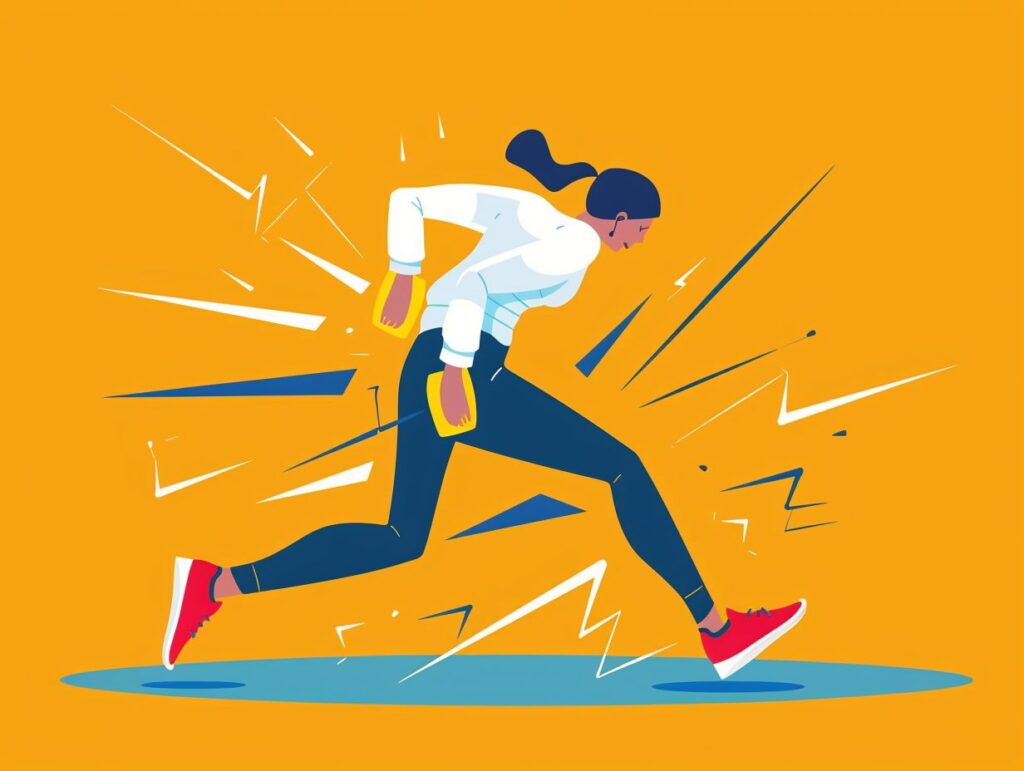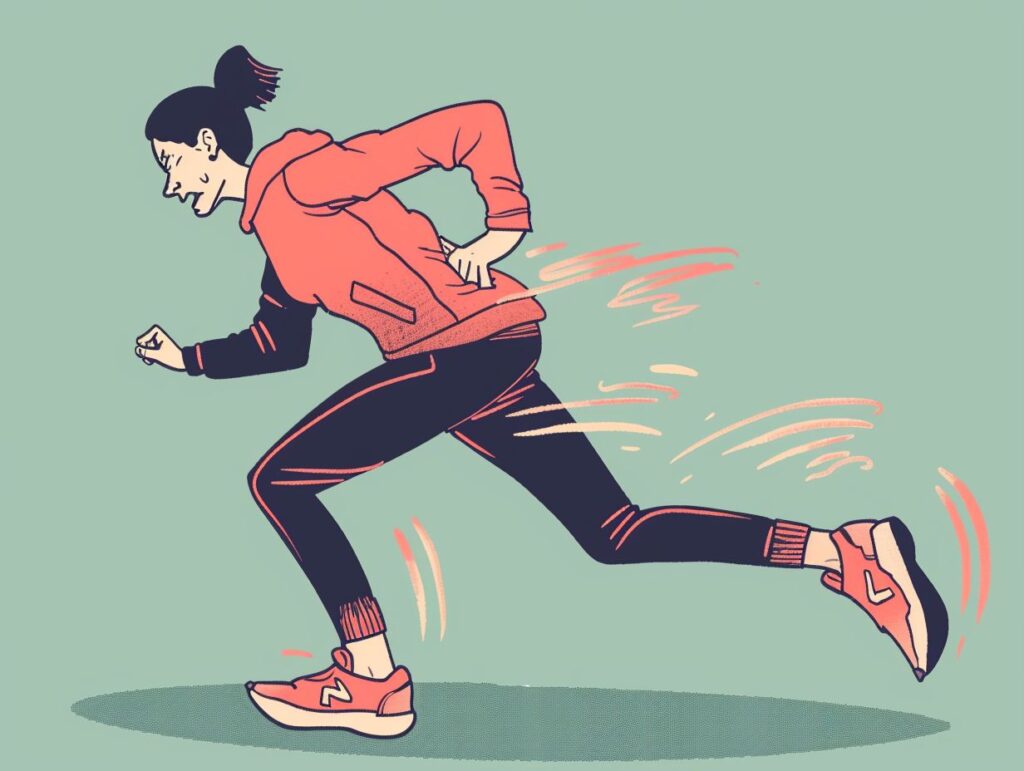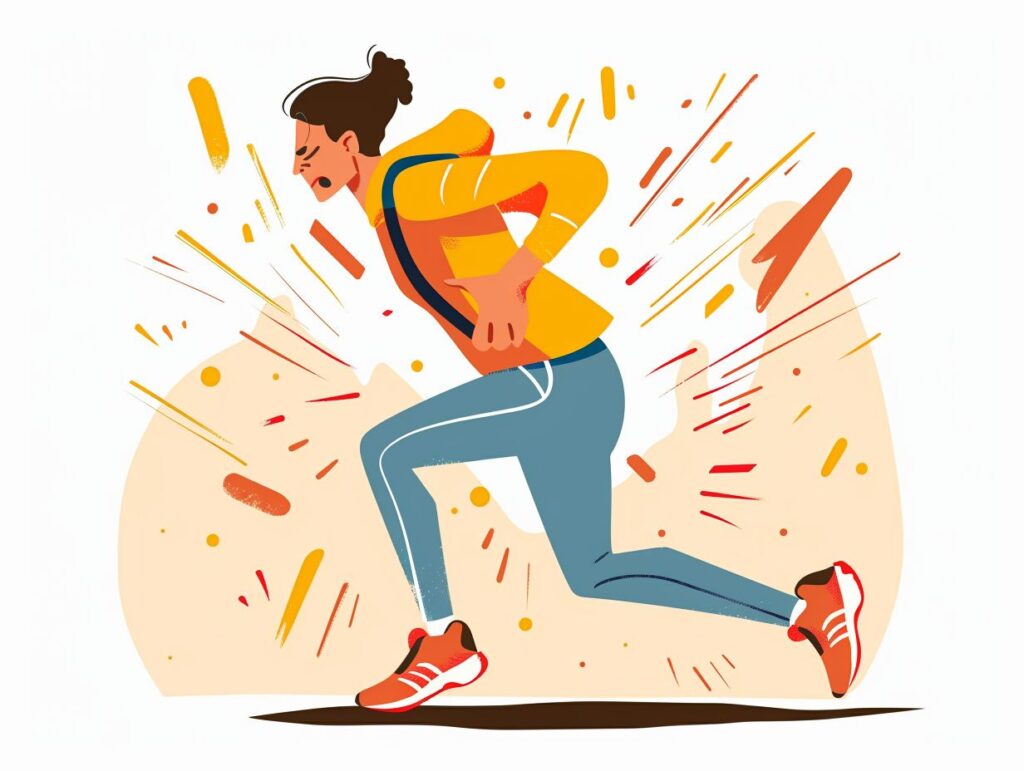- Are you experiencing lower back pain after your runs?
- Explore the common causes of this discomfort, how to prevent it, and common injuries that can lead to lower back pain after running.
- Get tips on adjusting your running technique to avoid this issue in the future. We will also cover treatment options and when it may be necessary to seek medical advice for your lower back pain.
- Lace up your shoes and let’s get started!
What Causes Lower Back Pain After Running?
Lower back pain after running can be caused by various factors related to the lumbar region of the spine. The repetitive impact and motion involved in running can put strain on the muscles and structures supporting the lower back, leading to discomfort and soreness.
Improper running form, such as overstriding or hunching over, can exacerbate the pressure on the lower back muscles, further contributing to pain. Overuse of the lower back muscles without proper conditioning or rest can also result in stiffness and discomfort. It’s crucial to pay attention to proper stretching, warm-up routines, and strengthening exercises to support the lumbar region and prevent strain while running.
Is It Normal to Experience Lower Back Pain After Running?
Experiencing lower back pain after running is relatively common for individuals engaged in physical activities like running. It can be a result of the stress placed on the lumbar region during the running motion.
The impact of running on the lower back can vary depending on factors such as running technique, footwear, and overall fitness level.
When the muscles in the lumbar region are not properly conditioned or if there is an imbalance in muscle strength, it can lead to discomfort post-running.
It is essential to pay attention to any discomfort symptoms and adjust your running routine accordingly to prevent exacerbating the lower back pain.
Incorporating strength training exercises targeting the core and lower back can help improve stability and reduce the likelihood of experiencing pain.
How to Prevent Lower Back Pain After Running?
Preventing lower back pain after running involves incorporating specific strategies to strengthen muscles, improve flexibility, and maintain proper form. These proactive measures can help reduce the risk of discomfort and injury.
One effective way to enhance muscle flexibility and prevent lower back pain is by implementing a regular stretching routine focusing on the hamstrings, hip flexors, and lower back muscles. Incorporating dynamic stretches before a run and static stretches post-run can help improve muscle elasticity and reduce tightness. Engaging in muscle strengthening exercises targeting the core, glutes, and lower back can provide stability and support to the spine during running. It is also crucial to pay attention to proper running form and posture, avoiding excessive arching or rounding of the back to prevent unnecessary strain on the lower back muscles.
Proper Warm-Up and Stretching
A crucial aspect of preventing lower back pain after running is engaging in a proper warm-up routine that includes dynamic stretching exercises. These activities help prepare the muscles for the impact of running, reducing the chances of discomfort.
Dynamic stretching exercises such as leg swings, high knees, and hip circles can increase blood flow to the muscles and improve flexibility, minimizing the strain on the lower back during a run.
By gradually increasing the heart rate and warming up the core muscles through exercises like trunk rotations and gentle jogging, runners can better distribute the workload throughout their body, thereby reducing the risk of injury or discomfort. Implementing a well-rounded warm-up routine is key in ensuring a safe and enjoyable running experience while also enhancing performance.”
Strengthening Core Muscles
Strengthening core muscles, especially those in the abdominal and lower back region, is essential for stabilizing the spine during running and reducing the risk of discomfort. Incorporating core strengthening exercises into the workout routine can help maintain proper posture and alignment.
This enhanced stability not only improves running performance by allowing for more efficient movement but also plays a crucial role in preventing lower back pain. By engaging the core muscles through exercises such as planks, Russian twists, and Superman holds, runners can build strength and endurance in the muscles surrounding the spine.
These targeted exercises help create a strong foundation that supports the body during the repetitive impact of running, reducing the likelihood of muscle strain or injury. Ultimately, a strong core acts as a protective shield for the lower back, promoting overall spine health and longevity in a runner’s training regimen.
Wearing Proper Shoes
Choosing the right footwear is crucial in preventing lower back pain while running. Proper running shoes provide adequate support and cushioning, reducing the impact on the spine and lower back muscles during each stride.
When selecting running shoes, it is essential to consider factors such as arch support, heel cushioning, and overall stability.
A proper fit is also key to ensuring that your feet are properly aligned, which can help alleviate strain on the lower back.
Investing in quality footwear designed specifically for running can make a significant difference in your overall comfort and performance.
By choosing shoes that prioritize support and cushioning, you can minimize the risk of discomfort and potential injuries, allowing you to fully enjoy your runs without worrying about lower back pain.
Maintaining Good Posture
Proper posture while running is essential for reducing strain on the lower back muscles and spine. Maintaining a stable and aligned posture helps distribute the impact of running evenly throughout the body and minimizes the risk of discomfort.
Good posture not only enhances your running performance but also plays a significant role in preventing lower back pain. When you maintain proper alignment, you reduce the strain on your muscles and joints, allowing them to work more efficiently.
To ensure a correct running posture, focus on keeping your head up, shoulders back, and core engaged. It’s also crucial to land softly on your midfoot or forefoot and maintain a slight forward lean from the ankles to maintain balance and prevent excessive stress on your lower back. By paying attention to your posture and alignment while running, you can help prevent muscle discomfort and injury.
What Are Some Common Injuries That Can Cause Lower Back Pain After Running?

Several common injuries can lead to lower back pain after running, including muscle strains, herniated discs, and spinal stenosis. These conditions can result from overuse, improper form, or pre-existing spinal issues.
Muscle strains, one of the most common causes of lower back pain among runners, occur when the muscles in the lower back are overexerted or overworked, leading to pain and discomfort. Symptoms of a muscle strain may include localized pain, stiffness, and reduced range of motion.
On the other hand, herniated discs occur when the soft inner material of a spinal disc protrudes outward, putting pressure on nearby nerves and causing sharp, shooting pain. This condition can also result in tingling, numbness, or weakness in the legs.
Spinal stenosis, a narrowing of the spinal canal that puts pressure on the spinal cord and nerves, can cause lower back pain that may worsen with activity. It often leads to radiating pain, weakness, or numbness in the legs.
It is vital for runners to recognize these symptoms early and seek appropriate treatment to avoid further complications and ensure a healthy recovery.
Muscle Strains
Muscle strains in the lower back can occur during running due to sudden movements or overexertion of the back muscles. These strains can lead to localized pain, stiffness, and discomfort that may worsen with physical activity.
They are a common injury among runners, often resulting from improper warm-up or poor running technique. The repetitive impact of running can put strain on the muscles supporting the lower back, leading to micro-tears and inflammation.
Over time, if not addressed, these strains can progress to more serious conditions, impacting daily activities such as walking, sitting, and bending. It is essential to listen to the body’s signals of discomfort and seek proper treatment to prevent further damage and aid in a quicker recovery process.
Engaging in exercises that strengthen the core muscles can also help prevent future muscle strains in the lower back.
Herniated Disc
A herniated disc can cause lower back pain after running when the cushioning between spinal vertebrae slips out of place. This condition can lead to nerve compression, radiating pain, and discomfort during physical activities.
Some common symptoms of a herniated disc include numbness or tingling in the legs, muscle weakness, and shooting pain down the leg. Diagnosis of this injury often involves a physical examination, imaging tests like MRI or CT scans, and discussing the individual’s medical history. Treatment options may range from conservative approaches such as rest, physical therapy, and pain management medications to more advanced interventions like epidural injections or surgery, depending on the severity of the herniation and its impact on the spine.
Spinal Stenosis
Spinal stenosis, a condition characterized by the narrowing of the spinal canal, can result in lower back pain after running. The compression of nerves in the lumbar region due to stenosis can lead to discomfort and radiating pain.
This compression can also affect the mobility of the individual, making it challenging to engage in physical activities like running. Symptoms of spinal stenosis may include tingling sensations, weakness, and numbness in the lower back and legs.
It’s crucial to differentiate between general muscle soreness from running and pain caused by an underlying spinal condition. Seeking early diagnosis and appropriate treatment, such as physical therapy, medication, or in severe cases, surgery, can help manage spinal stenosis effectively.
Spondylolisthesis
Spondylolisthesis, a condition where a vertebra slips out of place, can lead to lower back pain after running. The misalignment of the spinal vertebrae can result in discomfort, weakness, and instability in the lower back.
This dislocation of the vertebra puts pressure on the nerves and surrounding tissues, leading to shooting pain that worsens with physical activity, such as running. Individuals with spondylolisthesis may experience numbness or tingling in the legs due to nerve compression. Diagnosis typically involves imaging tests like X-rays or MRI scans to assess the extent of the spinal injury.
Treatment options range from conservative approaches like physical therapy and pain management to more invasive measures like spinal fusion surgery, depending on the severity of the condition.
How Can Lower Back Pain After Running Be Treated?
Treating lower back pain after running involves a combination of rest, therapy, and potentially medical interventions to manage discomfort and support recovery. These treatments aim to address the underlying causes of the pain and promote healing.
Rest is essential to allow the muscles to relax and recover from the strain of running. Physical therapy can help strengthen the muscles in the lower back and improve flexibility to prevent further injuries. Medical interventions such as anti-inflammatory medications or cortisone injections may be prescribed to reduce inflammation and alleviate pain. Heat and ice therapy can also provide temporary relief from discomfort. It is crucial to listen to your body, practice good posture, and gradually ease back into physical activities to avoid exacerbating the pain.
Rest and Ice Therapy
Rest and ice therapy are commonly used to treat lower back pain after running by reducing inflammation and providing relief to the affected area. Resting the back muscles and applying ice packs can help alleviate discomfort and promote healing.
Rest is crucial in allowing the body to repair itself, especially after the strain of a run. When combined with ice therapy, inflammation is reduced, and blood flow to the affected area is improved, facilitating quicker recovery.
To apply ice therapy effectively, it is recommended to wrap the ice pack in a towel and place it on the lower back for about 15-20 minutes at a time. This can be repeated several times a day, but it’s important to allow the skin to return to its normal temperature between sessions to prevent ice burn.
Over-the-Counter Pain Medication

Over-the-counter pain medication can be used to alleviate lower back pain after running by reducing pain and inflammation. Common medications like ibuprofen or acetaminophen can help manage discomfort and improve mobility.
Ibuprofen, a nonsteroidal anti-inflammatory drug (NSAID), works by blocking enzymes that cause pain and inflammation, helping runners find relief. Acetaminophen, on the other hand, is a pain reliever that can reduce discomfort without affecting inflammation. When taking these medications, it’s essential to follow recommended dosage guidelines to avoid potential side effects. By addressing the root cause of pain, these medications can provide the necessary treatment for post-running discomfort, allowing individuals to recover and continue their active lifestyle with less hindrance.
Physical Therapy
Physical therapy plays a crucial role in the treatment of lower back pain after running by addressing muscle imbalances, improving flexibility, and strengthening supportive structures. Tailored exercise programs can aid in discomfort management and long-term recovery.
- By targeting specific muscle groups that may have become weakened or tight from running, physical therapy can help rebalance the body and alleviate strain on the lower back.
- In addition to exercises, modalities such as heat therapy, ultrasound, and manual therapy techniques can further reduce inflammation and promote healing.
- Through consistent sessions with a physical therapist, individuals can learn proper body mechanics and posture to prevent future injuries and maintain overall spinal health.
Injections
Injections, such as corticosteroids or nerve blocks, may be recommended for severe cases of lower back pain after running to reduce inflammation and provide temporary relief. These interventions target specific areas of discomfort and can offer symptomatic relief.
Corticosteroid injections work by decreasing inflammation in the affected area, which can help alleviate discomfort and improve mobility. Nerve block injections, on the other hand, target and block pain signals from specific nerves to provide relief. The benefits of these injections include potentially faster pain relief compared to oral medications and localized treatment delivery.
It’s important to note that these injections may come with side effects such as temporary pain at the injection site, allergic reactions, or infection. Therefore, discussing the risks and benefits with a healthcare provider is crucial before undergoing this form of treatment.
When Should Someone See a Doctor for Lower Back Pain After Running?
Seeking medical attention for lower back pain after running is advisable if the discomfort persists, worsens over time, or is accompanied by additional symptoms like numbness or weakness. A healthcare provider can assess the condition, diagnose the underlying cause, and recommend appropriate treatment.
A doctor’s evaluation is crucial in determining the root cause of the pain and ruling out any serious conditions. It’s important to prioritize your health and seek medical advice if the discomfort hinders your daily activities or affects your mobility.
Delaying a consultation may lead to further aggravation of the issue and delay in recovery. By working with a healthcare professional, you can receive a personalized treatment plan tailored to your specific needs, ensuring a quicker and more effective recovery process. Remember, your doctor is there to help you address and manage your discomfort symptoms effectively.
How Can Running Technique Be Adjusted to Prevent Lower Back Pain?
Adjusting running technique can help prevent lower back pain by optimizing posture, stride mechanics, and muscle engagement. Modifying key aspects of running form can reduce stress on the lower back and enhance running efficiency.
Improving posture is crucial to maintaining proper alignment during running, which can alleviate discomfort in the lower back. Focus on keeping your head up, shoulders back, and core engaged to support your spine. Ensuring a proper stride length can help distribute impact more evenly throughout the body, reducing the strain on the lower back. Engaging your core muscles while running can also provide stability and support to prevent unnecessary pressure on the back muscles.
Shorten Stride Length
Shortening stride length while running can reduce the impact on the lower back and decrease the risk of discomfort. A shorter, more frequent stride can help distribute the force of running evenly and minimize strain on the lower back muscles.
This adjustment in running technique is crucial for runners looking to enhance their performance while safeguarding their body against potential injuries.
By focusing on a shorter stride length, individuals can also improve their running efficiency, as it encourages a more efficient use of energy and better overall biomechanics.
Modifying the stride mechanics to promote a shorter stride length can lead to a smoother, more controlled gait, ultimately translating to a more enjoyable and sustainable running experience with reduced discomfort.
Increase Cadence
Increasing cadence, or the number of steps per minute, can help prevent lower back pain after running by promoting a more efficient running form. A higher cadence reduces the stride length and encourages quicker, lighter footfalls, reducing impact on the lower back.
This adjustment in running technique shifts the workload from the lower back to the legs, where the larger muscle groups can better handle the stress. By maintaining a consistent cadence, runners can also improve their overall running efficiency, as it helps in better energy distribution and smoother transitions between strides. This subtle change in cadence not only minimizes discomfort but also enhances the body’s biomechanics, leading to a more sustainable and enjoyable running experience.
Engage Core Muscles

Engaging core muscles while running is vital for maintaining stability and reducing strain on the lower back. Strengthening and activating the core muscles can provide additional support to the spine and improve overall posture during running.
This engagement helps to distribute the impact of each stride more evenly throughout the body, preventing excessive stress on the lower back.
By incorporating specific exercises such as planks, Russian twists, and bicycle crunches into your workout routine, you can target the deep muscles of the core that are essential for stabilizing the pelvis and spine.
Focusing on proper running technique, such as maintaining a neutral spine and engaging the core with each step, can also significantly reduce discomfort and risk of injury.
It’s important to create a strong foundation through core strength to promote spinal alignment and enhance endurance while running.”
Maintain Good Posture
Maintaining good posture throughout the run can significantly reduce the risk of lower back pain. Proper alignment of the spine, shoulders, and hips promotes optimal running mechanics and minimizes strain on the lower back muscles.
To ensure proper posture while running, focus on keeping your head up, looking straight ahead, and engaging your core muscles. Avoid slouching or leaning too far forward, as this can increase strain on your lower back. Maintaining a relaxed arm swing and a slight forward lean from the ankles can help with overall body alignment. It’s also essential to land mid-foot with each step rather than on your heels to reduce impact on the spine. By practicing these running technique adjustments, you can prevent discomfort and potential injuries in the lower back region.
Frequently Asked Questions
What are the common causes of lower back pain after running?
The common causes of lower back pain after running include poor running form, muscle imbalances, inadequate warm-up or cool-down, overtraining, and underlying medical conditions such as arthritis or disc problems.
How can I prevent lower back pain after running?
To prevent lower back pain after running, make sure to warm up properly, maintain good running posture, strengthen your core and back muscles, and gradually increase your mileage and intensity. It is also important to listen to your body and take rest days when needed.
Why do I experience lower back pain after long distance running?
Long distance running can put a lot of stress on your lower back, leading to pain and discomfort. This can be due to improper form, fatigue, or inadequate training. Strengthening your core and back muscles and incorporating rest days into your training can help prevent this type of pain.
Is lower back pain after running a sign of a serious injury?
Lower back pain after running is not always a sign of a serious injury. It can be caused by muscle soreness or fatigue, which can be relieved with rest and proper recovery. However, if the pain persists or is accompanied by other symptoms, it is important to consult a medical professional.
Can wearing the wrong shoes cause lower back pain after running?
Yes, wearing the wrong shoes can contribute to lower back pain after running. Shoes that do not provide enough support or do not fit properly can put additional strain on your back and lead to discomfort. It is important to choose shoes that are designed for your foot type and running style.
When should I see a doctor for lower back pain after running?
If your lower back pain after running persists for more than a few days, is accompanied by other symptoms such as numbness or weakness, or significantly affects your daily activities, it is best to consult a doctor. They can help determine the cause of your pain and provide appropriate treatment.

My passion for martial arts goes beyond practice; it is a philosophy that shapes my writing, bringing a distinctive edge to my narratives and advice. I hold black belts in two martial arts disciplines and have competed internationally, experiences that enrich my storytelling with authenticity and excitement.

